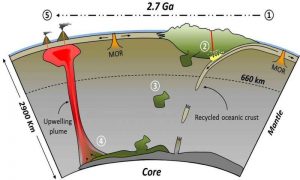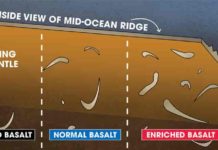
The raw materials of some volcanic islands are shaped by some of the same processes that form diamonds deep under the continents, according to a new study. The study asserts that material from diamond-forming regions journeys nearly to earth’s core and back up to form such islands, a process that could take two and a half billion years or longer—more than half of earth’s entire history. The research challenges some prevailing notions about the workings of the deep earth, and their connections to the surface. The study, led by researchers at Columbia University’s Lamont-Doherty Earth Observatory, appears this week in the scientific journal Nature.
In line with the theory of plate tectonics, scientists believe that many islands far out in the oceans are the product of mantle plumes—hot spots of material welling up from the vast region below earth’s thin crust to erupt on the ocean floor. Examples include the Hawaiian and Galápagos chains. Prevailing thought says the raw material is recycled ocean crust made of the volcanic rock basalt that has been shoved down, or subducted, under the lighter rocks of the continents. This material is then thought to sink as far as 1,800 miles to the mantle’s boundary with earth’s core, then rise back up.
The new study leaves this basic story intact, but adds an intriguing chapter for some lavas with peculiar compositions known as “HIMU,” meaning high μ, the Greek letter geochemists use as shorthand for the ratio of uranium to lead. The solid rocks of the continents stick down into the mantle like teeth set in gums. Thin ocean crust subducting under them often drags along carbon-rich limestone, a common ocean-floor sedimentary rock. Once near the continental roots, some of that carbon gets expelled as a fluid, interacting with and altering rocks there. A hundred miles or more down, this process forms diamond, a pure crystalline form of carbon that sometimes reaches the surface in rapid, explosive eruptions. The new study says chunks of the altered roots may also drop off and sink, to later re-emerge as part of an island-forming eruption.
The key to the finding: a connection between the chemistry of tiny bits of carbon-rich fluids, or inclusions, trapped within diamonds, and that of the lavas that form the HIMU islands. Diamond inclusions comprise the original carbon-rich fluid from which the diamond crystallized, and this fluid contains dozens of other elements that form characteristic abundance patterns. A defining characteristic of the fluids: a high ratio of calcium to aluminum. On the islands studied, the researchers found similarly high calcium-to-aluminum ratios in olivine, a mineral that crystallized from the magmas. They compared the abundance patterns of 28 other elements in the lavas, from cesium to lutetium, and found that the patterns also matched those within diamond inclusions. The conclusion: the diamonds and the lavas came from the same stuff. “It’s not every day that new observations force us to completely rethink a concept that has been accepted for decades,” said coauthor Cornelia Class, a Lamont-Doherty geochemist.
“Trace elements are the fingerprints of geologic processes,” said lead author Yaakov Weiss, a Lamont-Doherty geochemist who studies diamond inclusions. “The key link is that carbon-rich fluids in diamonds that formed 100 miles below the surface and magmas that welled up from 1,800 miles down have the same unique chemical signatures. We can look at diamonds as time capsules, as messengers from a place we have no other way of seeing.” Weiss last year published a study concluding that inclusions showed ancient seawater was involved in the formation of some diamonds.
The scientists analyzed HIMU lavas from the Cook-Austral islands in the south Pacific, and Grand Comore island, in the Indian Ocean. Most samples were taken by coauthor Takeshi Hanyu of the Japan Agency for Marine-Earth Science and Technology, who has previously studied the Cook-Austral rocks. (Another HIMU island, which the team did not study, is the Atlantic Ocean’s St. Helena, where Napoleon was imprisoned following his downfall.) All of these islands formed 20 million years ago or less, meaning that while they themselves are geologically young, their source material is extremely ancient.
The findings are bolstered by previous research from others showing that diamond inclusions and HIMU lavas both contain unique combinations of isotopes of the element sulfur that were common in earth’s atmosphere before 2 billion years ago, after which respiration from photosynthetic algae caused oxygen to accumulate in the air. This shows that the material for both diamonds and HIMU lavas came from the surface long ago.
“The idea that the subcontinental mantle contributes significantly to mantle plumes has been around for over 30 years, but never found general acceptance,” said coauthor Steven Goldstein, also a geochemist at Lamont-Doherty. “While this is likely not the last piece to the HIMU puzzle, it signals a major shift in our view of deep earth dynamics.”
One thing the study does not suggest: that diamonds might be found on oceanic islands. They might have been present in the continental root at the start of its journey, but would have been destroyed along the way.
Reference:
Yaakov Weiss et al, Key new pieces of the HIMU puzzle from olivines and diamond inclusions, Nature (2016). DOI: 10.1038/nature19113
Note: The above post is reprinted from materials provided by Columbia University.










